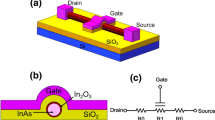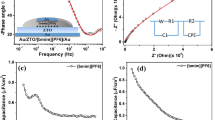Abstract
Optoelectronic synapses are devices that use electromagnetic radiation to mimic synaptic plasticity and its related functions. Such devices are considered key elements for the implementation of neuromorphic computing systems, that is, based on the functioning of the brain, with sensing, memory and learning properties. This work demonstrates an optoelectronic device with synaptic properties based on a thin-film transistor (TFT) configuration, with the semiconductor channel consisting by a zinc oxide (ZnO) film deposited by RF magnetron sputtering. The synaptic properties take advantage of the phenomenon of persistent photoconductivity presented by the ZnO film. The incidence of light in the channel increases the electrical current intensity measured between the drain and source electrodes (IDS)—for a given potential applied to the gate electrode (VGS). With this, the synaptic functions of sensing, short- and long-term memory, learning and relearning, and paired pulse facilitation, are verified in the ZnO TFT. The variations in IDS caused by lighting with ultraviolet (UV) radiation can reach up to 108 A, which demonstrates the high sensitivity of the device, a crucial aspect for its effectiveness in terms of recognizing and discriminating the light stimulus.









Similar content being viewed by others
Availability of data and materials
The data that supports the findings of this study are available within the article [and its supplementary material].
References
M.D. Godfrey, D.F. Hendry, The computer as von Neumann planned it. IEEE Ann. Hist. Comput. 15(1), 11–21 (1993)
W. Guo et al., Neural coding in spiking neural networks: a comparative study for robust neuromorphic systems. Front. Neurosci. 15, 638474 (2021)
H. Okano, T. Hirano, E. Balaban, Learning and memory. Proc. Natl. Acad. Sci. 97(23), 12403–12404 (2000)
J.C. López, A fresh look at paired-pulse facilitation. Nat. Rev. Neurosci. 2(5), 307–307 (2001)
G.H. Lee et al., Effect of weight overlap region on neuromorphic system with memristive synaptic devices. Chaos Solitons Fractals 157, 111999 (2022)
I. Raifuku et al., Halide perovskite for low-power consumption neuromorphic devices. EcoMat 3(6), e12142 (2021)
W. Xiao et al., High photosensitivity light-controlled planar ZnO artificial synapse for neuromorphic computing. Nanoscale 13(4), 2502–2510 (2021)
C. Wang et al., Thin-film transistors for emerging neuromorphic electronics: fundamentals, materials, and pattern recognition. J. Mater. Chem. C 9(35), 11464–11483 (2021)
Q. Wu et al., Photoelectric plasticity in oxide thin film transistors with tunable synaptic functions. Adv. Electron. Mater. 4(12), 1800556 (2018)
G. Wang et al., Simulation of retinal ganglion cell response using fast independent component analysis. Cogn. Neurodyn. 12(6), 615–624 (2018)
S.W. Cho et al., Progress of materials and devices for neuromorphic vision sensors. Nano-Micro Lett. 14(1), 1–33 (2022)
P. Wu et al., Instability induced by ultraviolet light in ZnO thin-film transistors. IEEE Trans. Electron Dev. 61(5), 1431–1435 (2014)
V. Brinzari, Mechanism of band gap persistent photoconductivity (PPC) in SnO2 nanoscrystalline films: nature of local states, simulation of PPC and comparison with experiment. Appl. Surf. Sci. 411, 437–448 (2017)
A.H. Peterson, S.M. Sawyer, Oxygen adsorption and photoconduction models for metal oxide semiconductors: a review. IEEE Sens. J. 21(15), 16409–16427 (2021)
Z. Ouyang et al., Research progress of p-type oxide thin-film transistors. Materials 15(14), 4781 (2022)
D.K. Ngwashi, T.A. Mih, R.B. Cross, The influence of ZnO layer thickness on the performance and electrical bias stress instability in ZnO thin film transistors. Mater. Res. Express 7(2), 026302 (2020)
T. Zhang et al., Influence of post-deposition annealing on the novel alloyed SnSxO1-x semiconductor in p-type thin-film transistors. Mater. Sci. Semicond. Process. 151, 107037 (2022)
F. Sun et al., Flexible artificial sensory systems based on neuromorphic devices. ACS Nano 15(3), 3875–3899 (2021)
D.A. Melnick, Zinc oxide photoconduction, an oxygen adsorption process. J. Chem. Phys. 26(5), 1136–1146 (1957)
R.S. Zucker, W.G. Regehr, Short-term synaptic plasticity. Annu. Rev. Physiol. 64(1), 355–405 (2002)
Acknowledgements
The authors are grateful for the support of Dr. Jeff Kettle from University of Glasgow and Prof. Neri Alves from Unesp-Presidente Prudente. To Dr. Dari de Oliveira Toginho Filho, for technical support; to LARX (X-ray Analysis Laboratory) of the PROPPG-UEL Multiuser Laboratory Center, for the use of the equipments; and to INEO, CNPq and CAPES for the financial support.
Author information
Authors and Affiliations
Corresponding author
Ethics declarations
Conflict of interest
All the authors declare that they have no known competing financial interests that could have seemed to affect the work reported in this research paper.
Additional information
Publisher's Note
Springer Nature remains neutral with regard to jurisdictional claims in published maps and institutional affiliations.
Supplementary Information
Below is the link to the electronic supplementary material.
Rights and permissions
Springer Nature or its licensor (e.g. a society or other partner) holds exclusive rights to this article under a publishing agreement with the author(s) or other rightsholder(s); author self-archiving of the accepted manuscript version of this article is solely governed by the terms of such publishing agreement and applicable law.
About this article
Cite this article
Nobre, J.H.F., Safade, A.S., Urbano, A. et al. A synaptic device based on the optoelectronic properties of ZnO thin film transistors. Appl. Phys. A 129, 203 (2023). https://doi.org/10.1007/s00339-023-06490-8
Received:
Accepted:
Published:
DOI: https://doi.org/10.1007/s00339-023-06490-8




